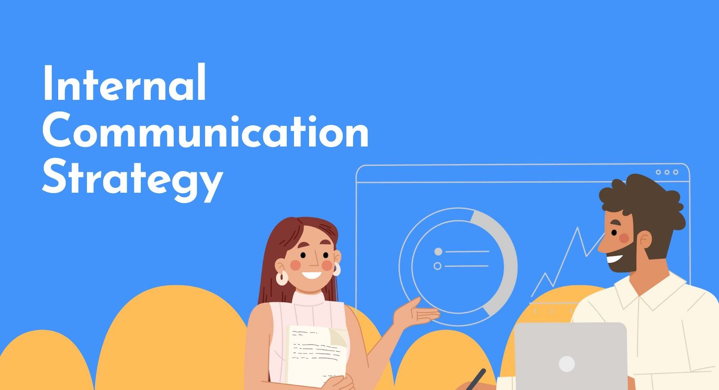Imagine an orchestra coming together to perform an epic symphony. The musicians are all world-class, their instruments are works of art, and the conductor has years of experience with the most complex musical pieces. A recipe for imminent success, right?
But as the musicians start to play, chaos ensues. What happened? It turns out someone switched the music scores, so each instrument is playing a different piece. Some musicians don’t have a score at all. Despite their best efforts, there’s no harmony, only confusion.
Your internal communication strategy is like that score. Without it, even with clear goals, the best tools, and top talent, creating the symphony you envisioned is nearly impossible.
But how do you make sure everyone plays the same tune? Or, rather, how do you create an internal communication strategy that works?
In this article, we’ll explore what an internal communication strategy is, its benefits and common challenges, and how to craft an effective strategy that addresses your company’s unique challenges.
What is an Internal Communication Strategy?
An internal communication strategy is a plan that helps organizations share important information with their employees, ensuring everyone stays informed, works together, and feels connected.
Creating an effective strategy involves developing key messages and selecting the right tools (emails, messengers, videos, or apps). Also, a strong strategy keeps employees motivated and engaged so that a company runs smoothly and everyone works toward the same goal.
Benefits of an Internal Communication Strategy
The main benefit is clear: everyone understands what they have to do to get things done. But there are many more:
📈 Increased motivation: When people know what to do, how to do it, and why it matters, they feel more motivated and have a greater sense of purpose.
⏱️ Boosted productivity: Clear communication and easy access to information reduce misunderstandings, leading to faster decision-making.
💙 Employee retention: People who develop a deeper level of trust in the company and its management, are less likely to leave.
👌🏼 Better crisis management: In tough times, an effective communication strategy keeps everyone calm and aligned.
🤝 Deeper trust: An internal communication strategy that incorporates transparency fosters trust between employees and leadership, enhancing overall morale.
Internal Communication Strategy Challenges
While the benefits are numerous, there are also challenges, especially in today’s remote and hybrid work environments and increasingly global teams. Here are a few:
- Information overload: You might think that more communication is better, but Zoom fatigue is real! And constant messenger alerts can overwhelm employees, causing them to tune out even important messages.
- Remote and hybrid workforces: It may be difficult to include remote workers, as there are much fewer opportunities for informal in-person communication and team building.
- Employee engagement: Companies often struggle to engage employees or gather productive feedback, especially if workers feel their input is ignored.
- Choosing the right channels: With the rapid evolution of communication channels, keeping up can be difficult. This leads to the use of ineffective tools (like emails for urgent matters).
- Cultural and language barriers: International teams may experience misunderstandings because of different cultural backgrounds and language nuances.
- Inconsistency: Sporadic or uneven communication between teams can cause confusion and a loss of direction.
- Measuring the results: Without tracking the effectiveness of your internal communication strategy, it’s hard to identify issues and make necessary adjustments.
Creating an Effective Internal Communication Strategy
So, you want to improve your internal communication—but where do you begin? Let’s walk through the process step by step to give you a straightforward guide.
📝 Analyze your current communication
- What communication channels do you use, and are they appropriate for different message types?
- Are all employees, including remote staff, easily reached and included?
- Do employees provide feedback regularly, and do they feel heard?
- Are your messages clear and consistent across the organization? Does everyone receive the same information?
- Do employees understand how their work contributes to shared goals?
- Do you have metrics to measure engagement, such as email open rates, meeting participation, or survey data?
Answering these questions will help you identify the gaps in your communication flow and provide a good starting point for improvement.
🗣️ Gather feedback from your team
Once you know what to ask for, reach out to your employees through surveys or interviews. Their perspectives will give you a deeper understanding of the situation, what works, and what should be changed. On top of that, people will appreciate your interest and will feel valued.
👱 Evaluate your audiences and environments
Your internal communication strategy shouldn’t be one-size-fits-all. Instead, cater to different groups and your work environment. For example, executives and leadership will need high-level, strategic updates. Managers require actionable messages to guide their teams. And remote workers will appreciate consistent, clear communication through digital tools.
There’s a generational difference as well. Gen-Zers and Millennials prefer messaging apps, while older generations may lean toward emails and in-person meetings.
As for environments, it’s helpful to consider whether your organization operates from the office, or everyone works remotely. Communication across multinational teams will require cultural and time-zone adjustments, so that’s also an important factor.
🎯 Set clear, measurable goals
While evaluating your current strategy, you may locate multiple pain points, so the main question will be which ones you should prioritize. To decide which issue to address first, determine how much of a discrepancy it causes, how urgent it is, and your time and budget constraints.
But most of all, you need to be able to measure the effectiveness of your efforts. So how will you do it? Will you rely on meeting attendance, email open rates, intranet analytics, or your team’s feedback? Choose the metrics to track so you can see how well your strategy works and make some tweaks when necessary.
Best Practices for Building an Internal Communication Strategy
No matter who your audiences are or where your organization operates, a few universal principles can help foster healthy, effective internal communication.
Be transparent
In internal communications, transparency means being open and clear when sharing both positive and negative information across the organization. Managers often worry that being transparent might make them or the company appear vulnerable, but in reality, it offers a lot of benefits.
When employees have access to timely, well-rounded information, it prevents rumors and misinformation. People feel more engaged, valued, and trusting of their leaders. To enhance transparency, consider the following:
- Keep the messages consistent across all levels.
- Share information proactively, not just in response to rumors.
- Provide an opportunity for employees to ask questions and share concerns.
- Explain why some information cannot be shared. This will help to strike a balance between openness and confidentiality.
Make Knowledge easily accessible and engaging
Providing your employees with quality, actionable information can greatly enhance their productivity and satisfaction at work. Here are a few strategies to achieve this:
🎥 Produce training videos: The human brain is wired to process visual information 60,000 times faster than text, making video the go-to format for work instructions and training materials.
🗂️ Keep materials organized and easy to access: An intranet hosting all your materials ensures people always know where to find the info they need while keeping the documents secure.
📖 Make your documents engaging: Digital tools offer numerous opportunities to enhance your static PDF documents. For example, you can turn guides, reports, and brochures into interactive documents that incorporate videos, GIFs, links, and surveys.
With tools like FlippingBook, you can also safely share your interactive materials on your Intranet or password-protect them to maintain confidentiality. It’s easy to update documents too—just replace the PDF, and everyone with the link will have access to the latest version.
You can also track your documents to see how many employees use them, what links they click, and what content resonates with them the most. This gives you actionable insights for improving your materials.
💫 Brand your content and communication tools: Making your internal materials and tools attractive and professional-looking will boost your employees’ pride in using them and foster a sense of connection, adding extra value to your team.
Empower your employees
Let your employees be heard. Not only will you gain important insights into your communication strengths and weaknesses, but your staff will also feel more included and valued.
When employees are happy with the company, they often become brand ambassadors, boosting your brand image and spreading awareness. Here’s what you can do:
- Conduct satisfaction and stay interviews to gauge employee happiness.
- Facilitate the use of employee-created content in your marketing campaigns.
- Encourage open discussions across departments and teams.
- Encourage peer-to-peer communication to increase collaboration and productivity.
- Share important company and personal milestones to spotlight and reward your employees, including informal gestures like giving kudos.
- Publish a regular company newsletter to build a sense of community.
- Incorporate interactivity into training sessions and other activities to increase engagement.
For instance, see how an interactive employee newsletter engages as well as informs. It’s easy to access and read, has a professional look, and reflects the company’s values and style.
Check-in regularly
Regular meetings, discussions, and interviews are essential for success. Consistent communication helps create stability, prevents misunderstandings from piling up, and ensures issues are resolved swiftly, boosting productivity.
Keep in mind though that not everyone feels comfortable sharing openly during meetings. Varying communication channels will ensure everyone is included in the conversation.
Another concern with regular meet-ups is information overload. Keep an eye on the meeting schedule so that your employees don’t spend most of their time on calls which builds exhaustion and stress. Additionally, you might try using meeting summary tools that help capture key points efficiently and reduce the need for extensive note-taking.
Create and maintain company culture
Company culture is often associated with dress codes and team-building activities and may seem only indirectly related to internal communication. However, it’s much more than that. It’s about your company’s values and how they are reflected in daily operations, relationships, and attitudes toward employees.
Build your company culture on respect, ethics, and openness, and your team will thrive.
Choose appropriate communication tools
While email is still a valuable communication tool, it’s not always the best choice—especially for urgent communications, as people typically check their email only a few times a day. Gen Z workers tend to avoid email altogether, and Millennials aren’t big fans either.
The following tools can complement emails or, sometimes, even replace them:
⭐ Intranet: A key communication tool, the intranet is a digital space that serves as your organization’s knowledge base. It’s where your staff can store documents, articles, guides, and charts, organized by teams or departments for easier management. Popular platforms include SharePoint and Happeo.
⭐ Instant Messaging Software: Even for companies operating from the office, tools like Slack or Microsoft Teams are indispensable for handling daily questions, task collaborations, file sharing, and making important announcements.
⭐ Digital Documents: Interactive documents in the flipbook format are much more effective than PDFs. They can be shared as links and opened on any device, incorporate different content formats, and can be easily protected from unwanted sharing. Also, detailed analytics gives you insights into how employees engage with the content, such as your internal newsletter or a training guide.
Ready to power up your PDFs?
Turn static files into professional digital documents for effective internal communication. Safely share your content as links and embeds, and track user activity for deeper insights.
⭐ Internal social networks: Corporate social networks, such as Yammer, Jive, or Workplace from Meta, help employees connect and communicate informally, improving the overall social climate in the workplace.
⭐ Video communication platforms: Zoom, Microsoft Teams, and Google Meet help remote and hybrid teams stay connected and collaborate effectively on complex projects that would take too long to discuss over email or chat.
⭐ Email platforms: While every organization has a standard email provider, tools like Mailchimp or SendGrid can be used for internal newsletters, targeted announcements, and updates. These platforms allow you to create professional-looking emails and track open and click rates to assess the effectiveness of your communication.
Remember that the more intuitive and attractive your tools are, the more your employees will want to use them.
Final Thoughts
At first glance, internal communication might not seem as important as client-facing communication since it doesn’t directly impact sales figures or brand image. But when you think about it, it influences a company’s success on many levels—from productivity to talent acquisition and retention. And it’s hard work too.
To make your internal communication strategy effective, you’ll need to consider many factors, have numerous conversations, prioritize and compromise, try different approaches, and continually tweak your processes.
However, as challenging as it is, internal communication can be incredibly rewarding—boosting morale and bringing out the best in your team. We hope this article has been helpful and that you’re ready to start making positive changes. Good luck!




